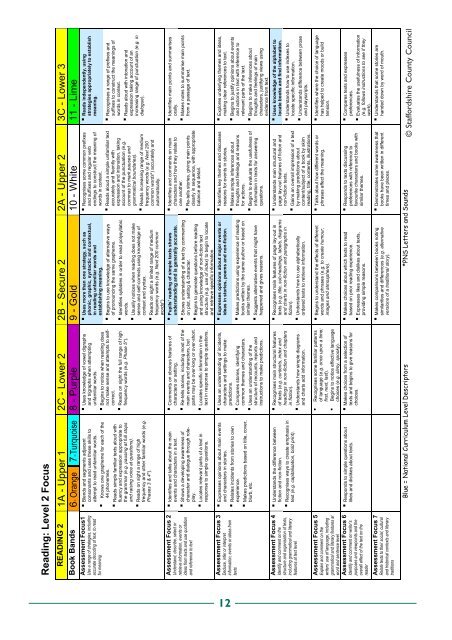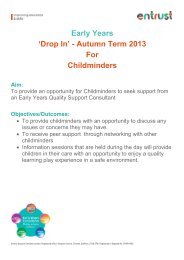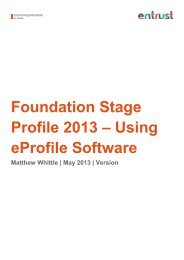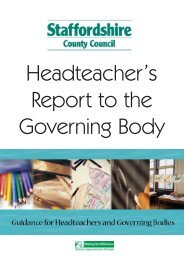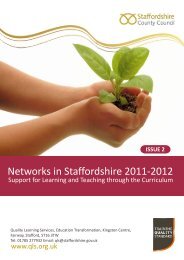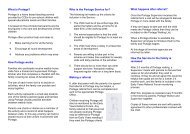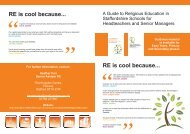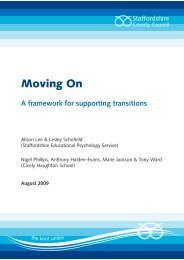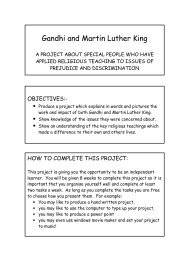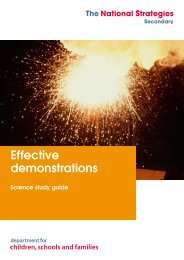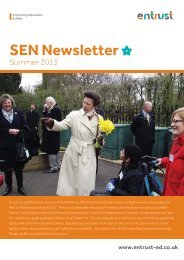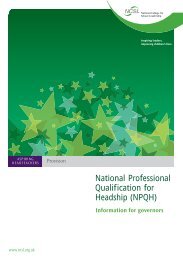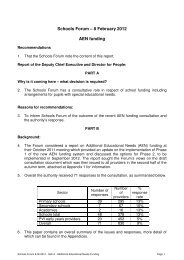Reading skills_save for pdf - Staffordshire Learning Net ...
Reading skills_save for pdf - Staffordshire Learning Net ...
Reading skills_save for pdf - Staffordshire Learning Net ...
Create successful ePaper yourself
Turn your PDF publications into a flip-book with our unique Google optimized e-Paper software.
<strong>Reading</strong>: Level 2 Focus<br />
READING 2 1A - Upper 1 2C - Lower 2 2B - Secure 2 2A - Upper 2 3C - Lower 3<br />
Book Bands 6- Orange 7-Turquoise 8 - Purple 9 - Gold 10 - White 11 - Lime<br />
Reads independently, using<br />
strategies appropriately to establish<br />
meaning.<br />
Recognises some common prefixes<br />
and suffixes and regular verb<br />
endings to construct the meaning of<br />
words in context.<br />
Reads aloud a simple unfamiliar text<br />
accurately and fluently with<br />
expression and intonation, taking<br />
account of the punctuation (e.g.<br />
commas to mark pauses and<br />
grammatical boundaries).<br />
Reads increasing range of medium<br />
frequency words (e.g. Next 200<br />
common words*) accurately and<br />
automatically.<br />
Uses more than one strategy, such as<br />
phonic, graphic, syntactic and contextual,<br />
in reading unfamiliar words and<br />
establishing meaning.<br />
Begins to use knowledge of alternative ways<br />
of pronouncing the same grapheme.<br />
Identifies syllables in order to read polysyllabic<br />
words.<br />
Usually notices when reading does not make<br />
sense and self-corrects using knowledge of<br />
context and syntax.<br />
Reads on sight a limited range of medium<br />
frequency words (e.g. Next 200 common<br />
words*)<br />
Pupils’ reading of simple texts shows<br />
understanding and is generally accurate.<br />
Shows understanding of a text by commenting<br />
on plot, setting & character.<br />
Begins to generate questions be<strong>for</strong>e reading<br />
and using knowledge of non-fiction text<br />
structure (e.g. use of index) to begin to locate<br />
and retrieve specific in<strong>for</strong>mation.<br />
Expresses opinions about major events or<br />
ideas in stories, poems and non-fiction.<br />
Uses knowledge of vowel digraphs<br />
and trigraphs when attempting<br />
unfamiliar words.<br />
Begins to notice when reading does<br />
not make sense and attempts to selfcorrect.<br />
Reads on sight the full range of high<br />
frequency words (e.g. Phase 5*).<br />
Blends and segments adjacent<br />
consonants and uses these <strong>skills</strong> to<br />
attempt to read unfamiliar words.<br />
Knows one grapheme <strong>for</strong> each of the<br />
44 phonemes.<br />
Reads simple familiar texts aloud with<br />
fluency and expression appropriate to<br />
the grammar (e.g. pausing at full stops<br />
and raising voice at questions).<br />
Reads on sight a range of high<br />
frequency and other familiar words (e.g.<br />
Phases 3 & 4*).<br />
Assessment Focus1<br />
Use a range of strategies, including<br />
accurate decoding of text, to read<br />
<strong>for</strong> meaning<br />
Recognises a range of prefixes and<br />
suffixes to construct the meanings of<br />
words in context.<br />
Reads aloud with intonation and<br />
expression taking account of an<br />
increasing range of punctuation (e.g. in<br />
dialogue).<br />
Identifies main points and summarises<br />
orally.<br />
Makes notes to summarise main points<br />
from a passage of text.<br />
Identifies and comments on main<br />
characters and how they relate to<br />
one another.<br />
Re-tells stories, giving main points<br />
clearly in sequence, with appropriate<br />
balance and detail.<br />
Comments on obvious features of<br />
characters or setting.<br />
Re-tells stories, including most of the<br />
main events and characters, but<br />
parts may be over-long or over-short.<br />
Locates specific in<strong>for</strong>mation in the<br />
text in response to simple questions.<br />
Identifies and talks about the main<br />
events and characters in a text.<br />
Shows a developing awareness of<br />
character and dialogue through roleplay.<br />
Locates relevant parts of a text in<br />
response to simple questions.<br />
Assessment Focus 2<br />
Understand, describe, select or<br />
retrieve in<strong>for</strong>mation, events or<br />
ideas from texts and use quotation<br />
and reference to text<br />
Explores underlying themes and ideas,<br />
making clear references to text.<br />
Begins to justify opinions about events<br />
and actions in text with reference to<br />
relevant parts of the text.<br />
Begins to make inferences about<br />
thoughts and feelings of main<br />
characters, justifying views using<br />
evidence from text.<br />
Uses knowledge of the alphabet to<br />
Identifies key themes and discusses<br />
reasons <strong>for</strong> events in stories.<br />
Makes simple inferences about<br />
thoughts and feelings and reasons<br />
<strong>for</strong> actions.<br />
Begins to evaluate the usefulness of<br />
in<strong>for</strong>mation in texts <strong>for</strong> answering<br />
questions.<br />
Uses an understanding of incidents,<br />
characters and settings to make<br />
predictions.<br />
Compares stories, identifying<br />
common themes and characters.<br />
Uses an understanding of the<br />
structure of recounts, reports and<br />
instructions to make predictions.<br />
Expresses opinions about main events<br />
and characters in stories.<br />
Relates incidents from stories to own<br />
experience.<br />
Makes predictions based on title, cover,<br />
blurb, etc.<br />
Assessment Focus 3<br />
Deduce, infer or interpret<br />
in<strong>for</strong>mation, events or ideas from<br />
texts<br />
12<br />
Makes predictions using experience of reading<br />
books written by the same author or based on<br />
similar themes.<br />
Suggests alternative events that might have<br />
happened and gives reasons.<br />
locate books and find in<strong>for</strong>mation.<br />
Understands how to use indexes to<br />
locate specific in<strong>for</strong>mation.<br />
Understands difference between prose<br />
and playscripts.<br />
Understands main structural and<br />
page lay-out features of fiction and<br />
non-fiction texts.<br />
Gains an overall impression of a text<br />
by making predictions about<br />
content/subject of a book by skim<br />
Recognises main features of page lay-out in<br />
texts (e.g. title, sub-headings, labels, diagrams<br />
and charts in non-fiction and paragraphs in<br />
fiction).<br />
Understands how to use alphabetically<br />
ordered texts to retrieve in<strong>for</strong>mation.<br />
Recognises main structural features<br />
of texts (e.g. contents, index and<br />
headings in non-fiction and chapters<br />
in fiction).<br />
Understands how simple diagrams<br />
and charts add in<strong>for</strong>mation.<br />
Understands the difference between<br />
fiction and non-fiction.<br />
Recognises ways to create emphasis in<br />
text (e.g. capitalisation, bold print).<br />
Assessment Focus 4<br />
Identify and comment on the<br />
structure and organisation of texts,<br />
including grammatical and literary<br />
features at text level<br />
Identifies where the choice of language<br />
has helped to create moods or build<br />
tension.<br />
reading, title, contents, illustrations.<br />
Talks about how different words or<br />
phrases affect the meaning.<br />
Begins to understand the effects of different<br />
words and phrases (e.g. to create humour,<br />
images and atmosphere).<br />
Recognises some familiar patterns<br />
of language (e.g. once upon a time;<br />
first, next, last).<br />
Begins to notice effective language<br />
choices (e.g. slimy, spooky).<br />
Makes choices from a selection of<br />
texts and begins to give reasons <strong>for</strong><br />
choices.<br />
Assessment Focus 5<br />
Explain and comment on the<br />
writers’ use of language, including<br />
grammatical and literary features at<br />
Compares texts and expresses<br />
preferences.<br />
Evaluates the usefulness of in<strong>for</strong>mation<br />
(e.g. follows instructions to see if they<br />
Responds to texts discussing<br />
preferences with reference to<br />
favourite characters and books with<br />
similar themes.<br />
Makes choices about which texts to read<br />
based on prior reading experience.<br />
Expresses likes and dislikes about texts,<br />
providing simple reasons.<br />
Responds to simple questions about<br />
likes and dislikes about texts.<br />
word and sentence level<br />
Assessment Focus 6<br />
Identify and comment on writer’s<br />
purposes and viewpoints and the<br />
overall effect of the text on the<br />
reader<br />
work).<br />
Understands that some stories are<br />
handed down by word of mouth.<br />
Demonstrates some awareness that<br />
books have been written in different<br />
times and places.<br />
Makes comparisons between books noting<br />
similarities and differences (e.g. alternative<br />
versions of a traditional story).<br />
Assessment Focus 7<br />
Relate texts to their social, cultural<br />
and historical contexts and literary<br />
traditions<br />
© Staf<strong>for</strong>dshire County Council<br />
Blue = National Curriculum Level Descriptors *PNS Letters and Sounds


